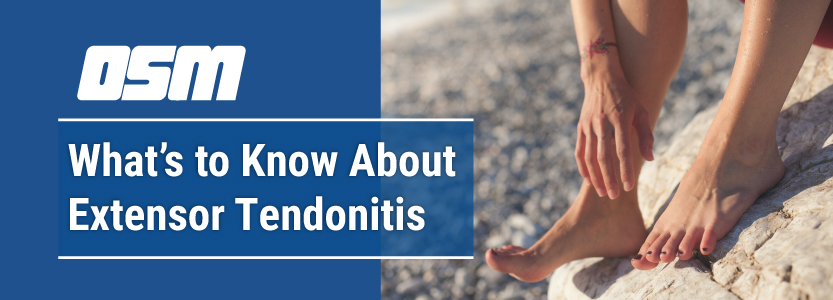What’s to Know About Extensor Tendonitis?
Article featured on MedicalNewsToday
The most common cause is overuse of the muscles, bones, and tendons in the feet or hands.
In the feet, it’s most often caused by:
- spending a lot of time on the feet
- wearing shoes that are too tight
- using inappropriate footwear for a sport or activity
In the hands, the most common cause of extensor tendonitis is doing an activity that uses the hands and wrists in a repetitive motion such as:
- prolonged or high-impact typing with a non-ergonomic keyboard
- practicing or playing an instrument, such as piano or guitar, excessively
- regularly playing sports that stress hands and wrists, including baseball or racquetball
Mallet finger is a common type of injury that occurs to the fingers, especially in athletes. It occurs when the tip of the finger is struck hard, such as with a ball, which injures the tendon that runs along the top of the finger.
Without treatment, the tendon can become permanently damaged, causing the tip of the finger to fail to straighten completely.
Symptoms and diagnosis
The most common symptom of extensor tendonitis, whether it occurs in the foot or the hand, is pain. In the feet, the pain is usually localized to the top of the foot, usually close to the center of the foot. In the hands, pain tends to occur on the top of the hand.
Other symptoms of extensor tendonitis include:
- redness, warmth or swelling near the injury
- increased discomfort with activity
- crepitus, which is a crunchy feeling or sound over the affected tendon
- stiffness of the joint
Diagnosing extensor tendonitis usually requires a physical exam and history with a physician. The doctor will ask questions about the pain and other symptoms.
Common questions are about whether anything makes the pain better or worse, the history of the symptoms, and if anything triggered the discomfort.
Sometimes, the doctor will order an X-ray or magnetic resonance imaging (MRI) test to get a detailed look at all the bones, muscles and tendons around the injury. These images can help the doctor look at the structures around the pain to see where the damage is and if there is another cause for the symptoms.
Treatment
Injuries to the hands and feet are common and usually resolve within a few days with basic care at home.
However, if the pain doesn’t start to improve after a couple of days, or a person experiences swelling, redness, warmth or other symptoms, they should visit their doctor.
There is a range of treatment options available for extensor tendonitis.
Rest and Relaxation
Resting the affected joint is crucial, especially if the tendonitis is caused by overuse. It is essential to stop the activity that is causing the pain until the tendon has healed, to prevent further injury. In less serious cases, rest may be all that is needed until the tendon has healed.
Finger or toe splints
Mallet finger may require splinting for several weeks so that the tendon returns to its previous position and completely heals in place.
It is important to clarify with the doctor about the length of time that the finger must remain in the splint. It is common to have to wear the splint continuously, even in the shower.
Removing the splint and moving the finger before the tendon has healed, could re-injure the tendon.
Physical therapy
Extensor tendonitis of the foot may require physical therapy and special stretches for a tight calf muscle. Also, some orthopedic surgeons or podiatrists will recommend the use of a splint or orthotic shoe inserts.
Surgery
Surgery to repair extensor tendonitis is rare and usually reserved for very special or unique cases. If considering surgical repair of the extensor tendons, people should ensure they see a surgeon who has experience performing these types of procedures.
Outlook
The prognosis of extensor tendonitis is excellent; in most cases, a person with this condition makes a full recovery without any lasting problems in the affected joints. How long it takes to recover depends on how severe the tendonitis was, and how well a person managed it.
For example, a person who rests properly will recover more quickly than someone who “pushes through” and continues to use the affected joint.
Although it can be painful, extensor tendonitis is a fairly preventable and easily treatable disease. It is important to see the doctor with any pain, especially in the hands or feet.
Quick diagnosis and treatment is the key to minimizing tendon damage and recovery.
The Orthopedic & Sports Medicine Center of Oregon is an award-winning, board-certified orthopedic group located in downtown Portland Oregon. We utilize both surgical and nonsurgical means to treat musculoskeletal trauma, spine diseases, foot and ankle conditions, sports injuries, degenerative diseases, infections, tumors and congenital disorders.
Our mission is to return our patients back to pain-free mobility and full strength as quickly and painlessly as possible using both surgical and non-surgical orthopedic procedures.
Our expert physicians provide leading-edge, comprehensive care in the diagnosis and treatment of orthopedic conditions, including total joint replacement and sports medicine. We apply the latest state-of-the-art techniques in order to return our patients to their active lifestyle.
If you’re looking for compassionate, expert orthopedic and podiatric surgeons in Portland Oregon, contact OSM today.
Phone:
Address
17355 Lower Boones Ferry Rd Suite 100A
Lake Oswego, OR 97035
Hours
Monday–Friday
8:00am – 4:30pm


